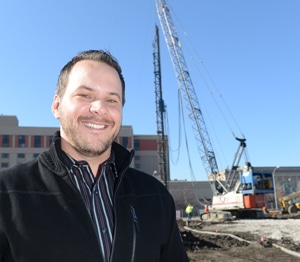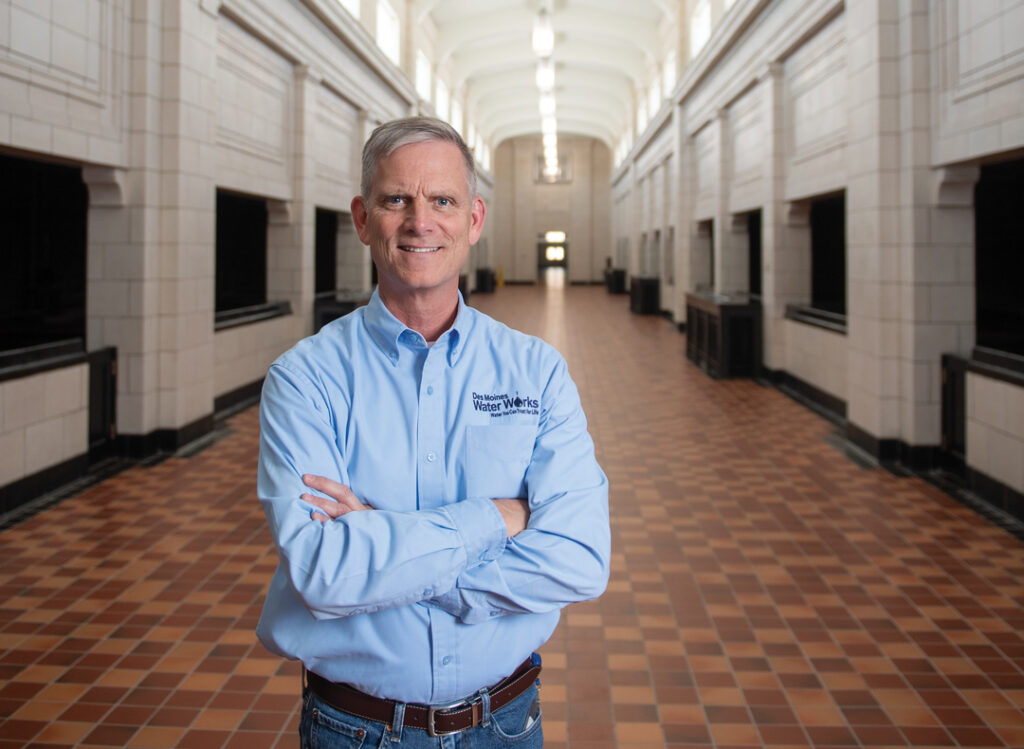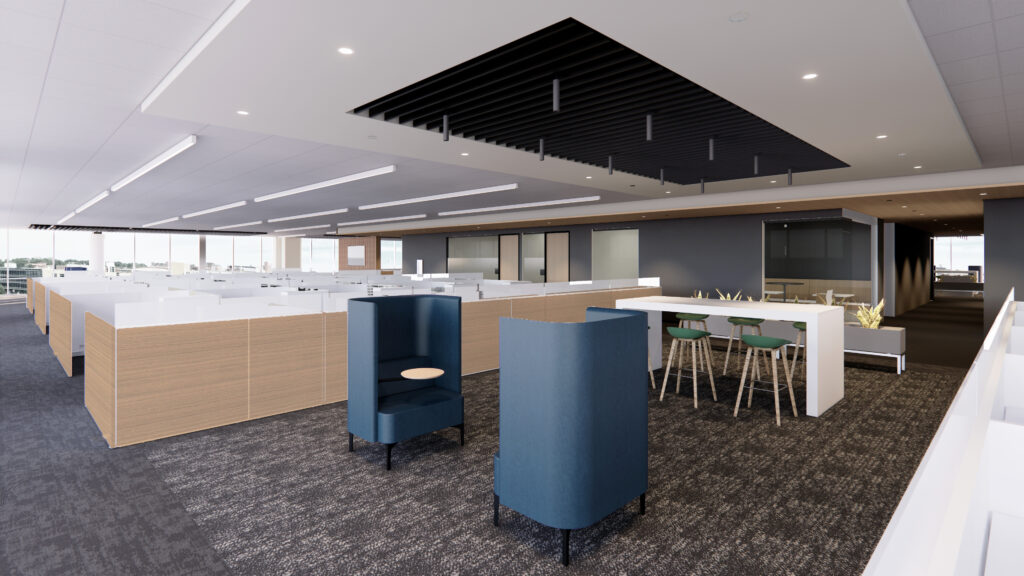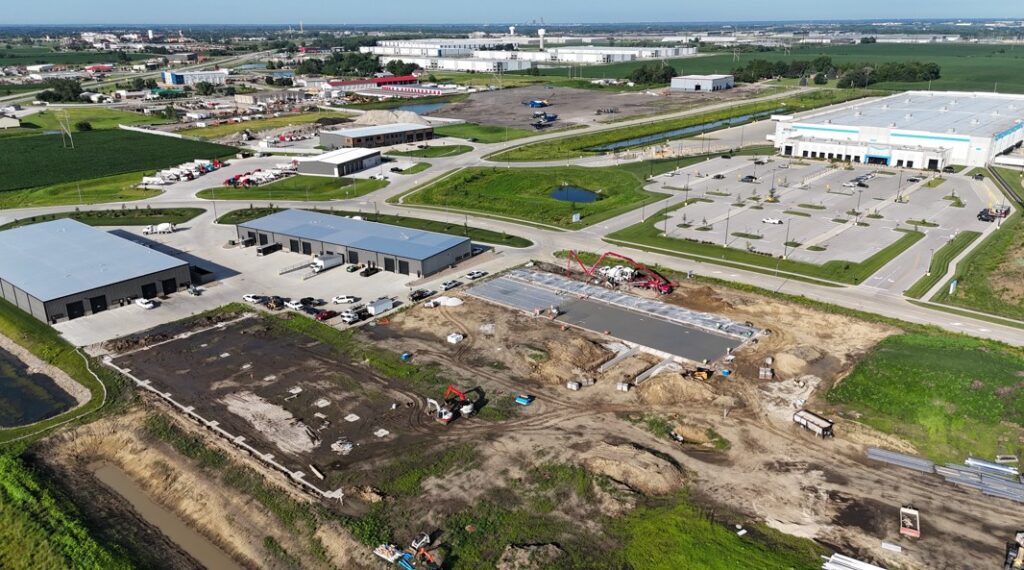The tracks of a city
Developers never know what they’ll find digGing through the past when working downtown

KENT DARR Feb 20, 2015 | 12:00 pm
9 min read time
2,151 wordsBusiness Record Insider, Real Estate and DevelopmentWhen boring through centuries of debris in downtown Des Moines, it helps to hold your breath and have a strong stomach.
Who knows what those 6-foot auger bits will unearth as they plummet through the rubble of breweries, tanneries, factories and fresh-as-the-day-it-was-dropped horse manure.
Jake Christensen is among many developers who have unearthed the sights and smells of the past while working downtown. And he isn’t alone. Developers working in or near the city’s urban core are sure to unearth the unexpected. It’s part of the fun, and the expense, of working downtown.
There’s the ice saw found near the Grand Avenue bridge, the rotting remnants a furrier left about 75 feet below what is now the Science Center of Iowa parking ramp, a truck that was in the debris removed from the Madison Flats apartment development in the southern reaches of downtown and trolley car rails that were removed from the Zombie Burger + Drink Lab building in the East Village.
“We constantly find buried buildings,” Christensen said.
Steve Niebuhr, senior vice president of construction and development for Hubbell Realty Co., said the cost difference between building downtown and in the suburbs is substantial, but oh the stories he can tell.
Hansen Real Estate Services Inc. had a veritable hotline to state archaeologists when it was renovating a former warehouse into Ballyards Lofts at South Third Street and Martin Luther King Jr. Parkway.
“Every time we had to dig, we needed an archaeologist on site,” said President Troy Hansen.
The company is boring at least 50 feet through the rubble of old buildings at East Second and Walnut streets in the East Village in order to pour the concrete stilts that its $49 million City Square apartment and hotel development will sit on.
These days, that rubble can’t sit in the ground. Developers must haul it out.
Much of what comes out of the ground adds up to many pieces of history and, in at least one instance, prehistory.
The Allied Mammoth, as it is called by the Iowa Historical Society, came out of the ground in pieces large and small in 2001, when crews were drilling holes for structural piers for the Nationwide/Allied parking ramp at 10th and Mulberry streets.
The Iowa Historical Society provides a narrative on its website for the way many discoveries are found, via drilling with crane-mounted augers in the search for firm footing.
“On August 14, 2001, an enormous auger, with a bit 6.5 feet wide, bore down through old building rubble, then through yards and yards of sand and gravel. At 10:30 in the morning, 55 feet below the surface, the auger struck bedrock—and bone. The auger had cut through the skeleton of a mammoth lying on the very floor of the Raccoon River valley.”
The giant auger smashed many of the bones, but crews were able to recover fragments from a portion of the right shoulder region, including vertebrae, a scapula, and parts of the front leg.
Those bits and pieces have been on display since 2004 at the State Historical Society of Iowa museum.
Carbon dating said the bones were more than 16,500 years old at the time they were discovered.
Other discoveries point back to a more recent history that included breweries that closed during the Prohibition Era, theaters that boasted movie screens and performance stages, liveries, and a range of factories and warehouses.
Dressing room below
“Time stood still” below the old Polk County Convention Complex, which is now the Wellmark YMCA at 501 Grand Ave.
Kevin Tubbs, director of business development for Graham Construction Co., was a project engineer for Ringland-Johnson-Crowley Co. when it built “The Plex” during the early 1980s.
The Capitol, renamed in 1929 to the Paramount Theater, originally stood on the spot. The 12-story building was razed in 1979 and paved over for the former Greyhound bus depot.
McAninch Corp. was hired to excavate the site for construction of the convention center.
“When we started building the convention center, we all knew there was still significant rubble left in the basement of the theater below the parking lot,” Tubbs said. “Our contract required that the rubble be dug out and replaced with engineered clay fill. As McAninch was digging the rubble out they discovered a wood floor structure. Once they broke through this floor structure, we discovered that there was a subbasement below the stage where the dressing rooms were at. After the building had been imploded and all that rubble sat on top of the floor structure, the dressing rooms were still intact and undisturbed.
“The makeup counters with the stools were still there. The mirrors and all the makeup lights surrounding the mirrors were undamaged. It looked like time had stood still down there.”
Crews also had to dig out the arched “Birds Run” sewer that ran underground through the site and encapsulate it in concrete.
“This was pretty delicate work because of the age of the old brick,” Tubbs said.
While doing that work, crews made another discovery.
“What was funny was as we were digging out alongside of the sewer, we found dozens of old glass whiskey bottles buried beside the sewer,” he said. “I think those old bricklayers must have really enjoyed their work in those days.”
Hansen goes deep for an East Village project
Dropping from a crane that towers roughly five stories above a chewed-up construction landscape in the East Village, an 18-inch auger is plunging 50 feet or so below ground seeking a point of failure. In this case, failure is a good thing, meaning the auger has found bedrock or compacted soil and can drill no deeper.
Long gone by this point in the process are tons of brick and mortar, concrete and steel, and even a whiskey bottle, all of which have been removed from the site. Although the address for the future City Square apartment and hotel project is 201 E. Locust St., the site occupies an entire square block.
Before the auger’s work is done, it will bore 520 holes, the shallowest at 37 feet, others at 58 feet, way beyond the typical 52-inch frost line where foundations are set in a typical greenfield construction site.
This isn’t a greenfield. This is old industrial land, where as the story goes for much of downtown Des Moines, time and sediment and the collapse and burial of old buildings has added several feet to the elevation.
All of those holes, 172 for the hotel alone, will be filled with concrete for an array of piers that will support the hotel and apartment building.
That drilling adds to the cost, but it already is factored into the $49 million project. A similar project built over farmland in the suburbs could come it at half that price, according to Hubbell Realty Co. estimates of the difference in the expense of building downtown as opposed to Waukee or similar suburbs.
It isn’t just the drilling that is expensive and time-consuming. Streets will be closed for the delivery of materials, such as the prefabricated concrete walls that will be used in part of the construction, and delivery trucks and construction equipment will follow circuitous routes around the city to avoid creating traffic jams in the East Village.
This is a large site, but not so large that construction materials can be delivered and stored until needed, as happens during construction in the wide-open suburbs.
“We tell (subcontractors) to be here and be prepared when we have a delivery scheduled,” said Tony Garcia, vice president of The Hansen Co. Inc.
By the way, those subcontractors and their crews are going to have to find their own parking spots; there is no room at the site.
Sounds like the proverbial hassle, but for Hansen and other developers, it’s worth the bother.
“These are projects that are easy for us to get excited about, as opposed to working in the suburbs,” Hansen said. “To me it’s just something about Des Moines and doing buildings that are unique.”
Hubbell unearths a tanker car and ‘stable messes’
Given the breadth of its development activities, it is little wonder that Hubbell Realty Co. has made some unique finds in and around downtown Des Moines, the kind of stuff it rarely unearths when building in the suburbs.
Hubbell Senior Vice President Steve Niebuhr said that livery operators saw the banks of the Des Moines and Raccoon rivers as dumping grounds for horse manure, which, still steaming, became part of the decaying building materials that have to be removed from a building site.
“It is clear that they used to take stable messes to the end of a bridge and dump them,” Niebuhr said. “Once you encounter it, you have to get rid of it.”
While excavating for the future River Point office complex, crews dug up a riveted-seam railroad tank car that was full of white gas that was used to light up the city’s street lamps.
“We had to get (the Iowa Department of Natural Resources) involved to figure out what it was,” Niebuhr said. “There were no regulations for the disposal of white gas.”
During the construction of its Cityville residential and commercial complex at the former Pittsburgh-Des Moines Steel Co. site on Southwest Ninth Street, crews have dug up “foundations the size of city buses”that supported presses and other manufacturing equipment.
“And one thing about working downtown, you can assume that at one time there was a gas station on every street corner,” Niebuhr said. “You try to do your homework upfront.”
But the research can let you down. Niebuhr said that on one job, crews were surprised to find six gasoline storage tanks.
“We thought the site had been cleaned up and the tanks had been removed,” he said.
During the floods of 1993, rising water stirred up buried building materials and left large voids that filled in with unstable sand, creating sinkholes that had to be filled.
Unstable materials such as old brick walls and corkscrewed beams require extra foundation work at the least and the deep search for stable soils and bedrock that will support a building, hence the drilling that is a common sight for deep structural systems such as caissons, piers and pilings.
“The question is how far down do you have to go to get to native material,” Niebuhr said.
The good and bad of building downtown
Steve Niebuhr ran a rough comparison of the cost of building multifamily housing downtown as opposed to building in the suburbs and found that costs are about 50 percent higher in the urban core.
“That has a lot of things factored into it: land price, logistics, tight sites, you go higher in the air; utility costs,” he said.
That difference also helps explain why tax incentives are crucial to making a project feasible, he said.
On the other hand, “there are usually costs that are cheaper downtown,” said Kevin Tubbs of Graham Construction Co. Utility runs typically are shorter, and less expensive, downtown, and building sprawling parking lots is less of an issue.
Assistant City Manager Matt Anderson, while agreeing that there are serious constraints in building downtown, pointed out that unlike in the suburbs, streets, water and sewer lines typically are in place at the start of construction.
And there is another benefit.
“The developers wouldn’t do it if they couldn’t make money,” he said.
Tubbs, Niebuhr and other developers shared some of the logistical problems they learn to deal with when working downtown versus on a greenfield site.
Stage material:
Generally, the downtown sites are very constricted and the new building fills up the majority of the site, where a greenfield site usually has plenty of room to work and stage material and equipment. “We use what is called ‘just in time’ delivery of material, which means delivering it at the specific time it is needed,” Tubbs said.
Crane operation:
There may be very limited space to operate a crane around the building, so the contractor may need to build the project in a different sequence, operating from inside the building and working its way out of the building with the crane.
Traffic issues:
When a project is blocking traffic, the city of Des Moines usually requires the hiring of an off-duty police officer for traffic control.
Parking for employees:
Workers have to park in the ramps or at meters. There typically is abundant free parking at a greenfield site.
Storm water:
Storm water detention is problematic and more costly downtown. On a greenfield site, there is usually enough open space to dig a detention pond. Because of limited space, many sites downtown require underground storage or detention on a roof, which requires shoring up the structure.
The unknown:
All the “unknown buried stuff” can present challenges too. Tubbs did say that he once found a car buried in a coal mine shaft on a suburban construction site.










